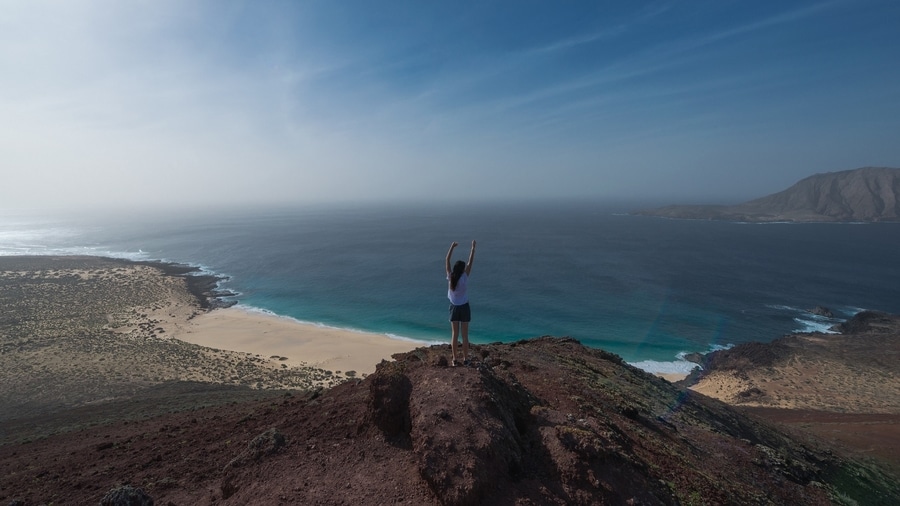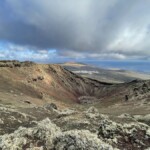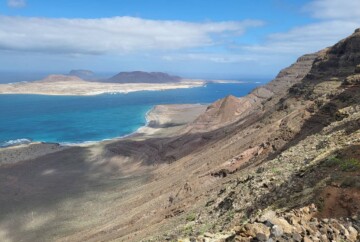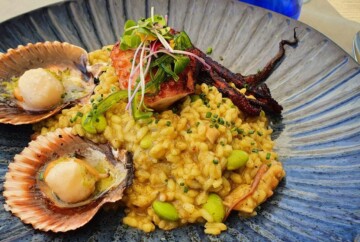If you’re coming to Lanzarote, your visit won’t be complete without exploring some of the volcanoes in Lanzarote. Without a doubt, these natural wonders are the undisputed protagonists of the Island of the Volcanoes, and Lanzarote is covered with numerous craters and badlands that you can visit.
Although it’s difficult to estimate how many volcanoes there are in Lanzarote, the locals call it “the island of 1,00 volcanoes,” and it’s one of the most recommended Canary Islands for those seeking adventure and otherworldly landscapes.
While most of them are extinct, there are some active volcanoes in Lanzarote inside Timanfaya National Park, one of the best places to visit in Spain. We’ve done the Route of the Volcanoes several times, and we still think it’s one of the best things to do in Lanzarote, so I cannot stop recommending it.
However, there are also other volcanoes in Lanzarote that you can visit. For this reason, I have created this guide with everything you need to know to visit each one of them, and for you to get the most out of this spectacular destination.
1. The Fire Mountains and the Route of the Volcanoes of Timanfaya, Lanzarote
First, the Fire Mountains are the only active volcanoes in Lanzarote, and they occupy approximately a quarter of the entire island’s surface area. This place seems like it’s from another planet, which is why it’s one of the most famous excursions in Lanzarote.
You can visit Los Volcanes Natural Park for free, although it’s worth signing up for one of the Lanzarote volcano tours. If you decide to visit on your own, you have two options. First, you can do the volcano route by bus, which leaves the Visitor Center every half hour. This 8-mile route will allow you to admire the beauty of the landscape, and it’s one of the most popular activities in the park.

1. The Fire Mountains and the Route of the Volcanoes of Timanfaya, Lanzarote
In addition, at the end of your visit, you will be able to go to the Islote de Hilario, an area of the park exclusively designated for geothermal demonstrations, where you will appreciate the high temperatures that are hidden under the surface. Another very popular activity is taking a camel ride, but I don’t recommend it, as I believe that you can fully enjoy this natural wonder without doing these types of tours with animals.
On the other hand, another way to visit Timanfaya National Park is on foot, hiking through the malpaís, where you can identify different formations such as small lava tubes and craters. We did the Ruta del Litoral, which is about 5.6 miles long, as well as the Tremesana Route, which goes past landscapes that resemble the surface of Mars. Both were amazing, so I definitely recommend them.
Of course, no matter how you visit these volcanoes of Lanzarote, I suggest having lunch at Restaurante El Diablo. Here, the food is cooked in a clay oven that connects to the depths of the earth, so you can enjoy your geothermally cooked meal while taking in the special surroundings.
2. Volcán de Caldera Blanca, one of the most famous Lanzarote volcanoes
Volcán de Caldera Blanca is another one of the most popular volcanoes in Lanzarote. It was formed from the great succession of volcanic eruptions that took place between 1730 and 1736. The route to reach its peak, which is around 1,640 feet high, is one of the most beautiful hikes in Lanzarote. The 3,937-foot-wide crater is perfectly preserved and offers spectacular views of the surroundings.

2. Volcán de Caldera Blanca, one of the most famous Lanzarote volcanoes
To do this, you must go to the town of Mancha Blanca and drive to Timanfaya National Park. On the way, you will find a detour on the road to this volcano, about 1.2 miles from the Visitor Center.
The walk will take you around 4 hours and cover a distance of 6.2 miles in a circular route through one of the best national parks in Spain. Thanks to the fact that it’s not very difficult, this route is suitable for most people, and you can even bring the kids along.
3. Volcán de La Corona, one of the best volcanoes in northern Lanzarote
Volcán de La Corona is a 3,000-year-old volcano in Lanzarote, and one of the most representative since it had such a strong eruption that it managed to considerably increase the surface of the island. Thus, the Malpaís de la Corona was born, which covers nearly seven square miles of the sea. It also gave rise to a variety of fantastic volcanic formations that have become the most visited attractions on the island: Jameos del Agua and Cueva de los Verdes.

3. Volcán de La Corona, one of the best volcanoes in northern Lanzarote
If you want to hike to the top, you will find the beginning of the trail in the town of Ye. It is a beautiful walk where you can see how the landscape changes as you gain altitude, so it’s very interesting. First, you will go through a ravine, which is of great economic value to the island, and then it becomes a steep climb to the crater.
You can complete this route in around three hours, and as a reward, you will have panoramic views that include the surroundings of Lanzarote, its neighbor La Graciosa, and an endless ocean. In addition, you can go down to the bottom of the crater, an experience that will make you feel incredibly small compared to the structure’s magnitude.
4. Montaña Bermeja, a volcano in La Graciosa, Lanzarote
Next, Montaña Bermeja is another volcano in Lanzarote that you can explore. Located on the island of La Graciosa, it’s one of the main attractions of this small island and one of the best hikes I did during our first trip.
While the 525-foot climb is quite steep, it should take less than a half hour to reach the viewpoint, where you’ll have incomparable panoramic views of the surroundings and the turquoise waters of the Atlantic Ocean. For this reason, I think it is totally worth it.

4. Montaña Bermeja, a volcano in La Graciosa, Lanzarote
On the other hand, when you get to the top, you can find a collection of messages from all the visitors who dared to go on this adventure. Don’t hesitate to leave your personal mark while you contemplate Las Conchas Beach at the foot of the volcano, as well as Montaña Amarilla, El Mojón, and Las Agujas.
Keep in mind that if you feel like going on this adventure, I recommend you book a ferry ticket at least a week in advance.
5. Montaña Blanca, one of the top volcanoes in the center of Lanzarote
Montaña Blanca is one of the highest volcanoes in Lanzarote, so it dominates the center of the island. This 6,450-foot-tall mountain is completely different from the rest since it has a pale white color that stands out among the volcanic landscape of black and ochre tones.

5. Montaña Blanca, one of the top volcanoes in the center of Lanzarote
If you want to visit it, you should go to the town of Tías, or to San Bartolomé, two towns that I particularly love. I recommend taking this time to discover the culture and gastronomy of these places after exerting yourself on the mountain.
To reach the top of Montaña Blanca, you’ll have to walk for two hours through a meadow, which, depending on the time of year, is covered with beautiful red poppies, and which are a true sight to behold. Also, you may come across some goats that will come to greet you as you make your way to the top.
6. Volcán del Cuervo, in Lanzarote’s Los Volcanes Natural Park
Volcán del Cuervo is one of the volcanoes in Lanzarote that are located within Los Volcanes Natural Park. However, this particular volcano has a special history since it’s said that it was the first volcano to emerge in Timanfaya, creating La Caldera de los Cuervos.

6. Volcán del Cuervo, in Lanzarote’s Los Volcanes Natural Park
Today, this is a natural space that attracts both adults and families with children, as it offers an easy path where you can appreciate dreamlike landscapes. If you complete this route, you will enter the volcano’s 115-foot-deep caldera, one of the most incredible experiences on the island. Walking among its rocky formations is an indescribable sensation, and you will also be able to identify lava remnants from the latest eruptions.
When you finish this 3.1-mile route, you can visit Bodega La Geria and taste some of the local wines from the area. We did this vineyard tour and we loved it, so if you’re looking for something to do after the hike, this may be a good option.
7. Caldera Colorada, another volcano in Lanzarote that you can visit
While planning your volcano route in Lanzarote, Caldera Colorada is another site that you should consider. This volcano has an intense red color that stands out among the brown and ochre tones of the surrounding lava field, so if you visit it, you will discover a different volcanic environment.

7. Caldera Colorada, another volcano in Lanzarote that you can visit
However, the most exciting part for many visitors is discovering the world’s largest volcanic bomb, which was ejected directly from inside the volcano 300 years ago.
If you want to do this hike, you’ll find the trailhead in the small town of Mancha Blanca, next to Tinajo. This route is very simple, so it’s suitable for those traveling with children or simply for those who don’t want to exert too much effort. The 1.8-mile trail is mostly flat and even, so I recommend it if you’re looking for a pleasant hike.
8. Montaña Teneza, an impressive Lanzarote volcano you should visit
Montaña Teneza is a volcano in Lanzarote where you can seek refuge from the tourist crowds. Many visitors dedicate their time to visiting Timanfaya, so they miss these small natural jewels where they can find a peaceful environment.

8. Montaña Teneza, an impressive Lanzarote volcano you should visit
If you’re visiting Tinajo, I recommend you take the hiking route that takes you to the top of Montaña Teneza. It takes about an hour, and the views from there are beautiful since you’ll be able to appreciate the rural side of the island, some volcanic beaches, natural pools, and incredible formations like the Ana Victoria cave. Legend has it that a pirate’s treasure was found there.
In addition, this path serves as an access point to some dreamy coves such as Tenesar and Las Malvas, so you can take a dip in the water when you finish the hike.
9. Montaña Roja, one of the best Lanzarote volcanoes in Playa Blanca
Playa Blanca is home to some of the best beaches in Lanzarote, but there are other attractions to see there. In this town, you can find another famous volcano in Lanzarote: Montaña Roja.

9. Montaña Roja, one of the best Lanzarote volcanoes in Playa Blanca
Located in the southern part of the island, this site attracts many visitors who want an easy walk with amazing views. The beginning of the trail is in the town of Los Claveles, about 2.4 miles from the center of Playa Blanca, so you don’t have to go too far. From there, all you have to do is follow the path, which is well-marked with signposts.
If you still feel like exploring further, you can go around the crater, or even head down inside. If you have some doubts, I say go for it, as the views are quite different and simply stunning. Plus, this crater is the main character of several local legends, and it’s said that aliens and UFOs have been sighted here. So, are you daring enough to check it out?
10. Montaña Rajada, one of the Lanzarote volcanoes you’ll see on the Tremesana Route
Lastly, Montaña Rajada is another Lanzarote volcano you’ll find in Los Volcanes Natural Park. It’s surrounded by one of the most spectacular landscapes on the entire island, which includes red, black, and ochre-colored craters and slopes.

10. Montaña Rajada, one of the Lanzarote volcanoes you’ll see on the Tremesana Route
However, you can’t visit it on your own; rather, you must go to the Visitor Center and take the volcano bus route, which will allow you to witness the beauty of this place. Another option is to do the Tremesana Route on foot, which will allow you to get closer to this incredible volcano, with a guide, of course.
Moreover, the Mar de Lava viewpoint offers panoramic views of the coast and Timanfaya National Park, so it’s the perfect reward for all your hard work.
Map of Lanzarote volcanoes
And that is all you need to know to plan your volcano route in Lanzarote. To finish up, here is a map with all the Lanzarote volcanoes I mentioned so you can easily locate them and plan your trip.
If you have any questions or want to share your experience visiting the best volcanoes in Lanzarote, feel free to leave me a comment below. I will be delighted to hear from you.
Enjoy the Island of Volcanoes!




















Montana Rajada, when did it last erupted? I did the Tremesana guided walk but haven’t been able to find detailed geological facts about that actual volcano.
Thanks
Hi Julie,
It looks like it last erupted on September 19, 2021. I haven’t found a ton of information about it, but you can get more insights here.